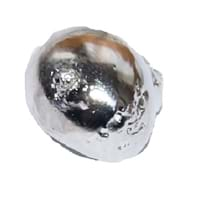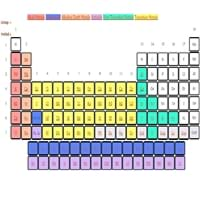Rhodium vs Berkelium
Periodic Table
Symbol
Rh
Bk
Group Number
9
9
Not Available
Period Number
5
7
Block
d block
f block
Element Family
Transition Metal
Actinide
CAS Number
7440166
99+
7440406
99+
Space Group Name
Fm_ 3m
P63/mmc
Space Group Number
225.00
2
194.00
5
Facts
Interesting Facts
- Rhodium is the rarest element out of all non-radioactive metals on the earth .
- Rhodium is one of the most durable and hard metal, which also have high reflectance.
- X-ray Diffraction- different compounds of Berkelium metals are identified using it.
- Commercial uses of Berkelium metal are not yet discovered.
Sources
Earth's crust, Found As a By-product, Found in Minerals, Mining
Bombarding Americium with Alpha Particles.
History
Who Discovered
William Hyde Wollaston
Lawrence Berkeley National Laboratory
Discovery
In 1804
In 1949
Abundance
Abundance In Universe
6 * 10-8 %
26
Not Available
Abundance In Sun
~0.0000002 %
25
~-9999 %
Abundance In Meteorites
0.00 %
36
Not Available
Abundance In Earth's Crust
0.00 %
99+
Not Available
Uses
Uses & Benefits
- Rhodium metal is mainly used in catalytic converters for cars as it reduces nitrogen oxides in exhaust gases.
- It is used as an industrial catalyst for nitric acid, acetic acid, hydrogenation reaction, etc.
- This metal is very rare and has no commercial uses.
Industrial Uses
Aerospace Industry, Automobile Industry, Electrical Industry, Electronic Industry
NA
Medical Uses
NA
NA
Other Uses
Alloys
NA
Biological Properties
Toxicity
NA
Unknown
Present in Human Body
No
No
In Blood
Not Available
0.00 Blood/mg dm-3
37
In Bone
Not Available
0.00 p.p.m.
36
Physical Properties
Melting Point
1,966.00 °C
12
986.00 °C
99+
Boiling Point
3,727.00 °C
17
2,627.00 °C
40
Appearance
Physical State
Solid
Solid
Color
Silvery White
Silver
Luster
Metallic
Metallic
Hardness
Mohs Hardness
6.00
6
Not Available
Brinell Hardness
980.00 MPa
9
Not Available
Vickers Hardness
1,100.00 MPa
9
Not Available
Speed of Sound
4,700.00 m/s
15
Not Available
Optical Properties
Reflectivity
84.00 %
4
Not Available
Allotropes
No
No
α Allotropes
Not Available
Not Available
β Allotropes
Not Available
Not Available
γ Allotropes
Not Available
Not Available
Chemical Properties
Chemical Formula
Rh
Bk
Isotopes
Known Isotopes
16
23
14
25
Electronegativity
Pauling Electronegativity
2.28
3
1.30
32
Allred Rochow Electronegativity
1.45
16
1.20
27
Allen Electronegativity
1.56
24
2.70
1
Electropositivity
Pauling Electropositivity
1.72
99+
2.70
22
Ionization Energies
1st Energy Level
719.70 kJ/mol
29
601.00 kJ/mol
99+
2nd Energy Level
1,740.00 kJ/mol
26
1,186.00 kJ/mol
99+
3rd Energy Level
2,997.00 kJ/mol
27
2,152.00 kJ/mol
99+
4th Energy Level
Not Available
3,434.00 kJ/mol
99+
Electrochemical Equivalent
1.28 g/amp-hr
99+
3.07 g/amp-hr
16
Electron Work Function
4.98 eV
6
Not Available
Other Chemical Properties
Anti Corrosion, Ionization, Radioactive Isotopes
Ionization, Radioactive Isotopes, Radioactivity
Atomic Properties
Atomic Number
45
99+
97
21
Electron Configuration
[Kr] 4d8 5s1
[Rn] 5f9 7s2
Crystal Structure
Face Centered Cubic (FCC)
Double Hexagonal Close Packed (DHCP)
Crystal Lattice
FCC-Crystal-Structure-of-Rhodium.jpg#100
DHCP-Crystal-Structure-of-Berkelium.jpg#100
Atom
Number of Protons
45
99+
97
21
Number of Neutrons
58
99+
150
11
Number of Electrons
45
99+
97
21
Radius of an Atom
Atomic Radius
134.00 pm
99+
170.00 pm
22
Covalent Radius
142.00 pm
99+
Not Available
Van der Waals Radius
200.00 pm
28
Not Available
Atomic Weight
102.91 amu
99+
247.00 amu
18
Atomic Volume
8.30 cm3/mol
99+
Not Available
Adjacent Atomic Numbers
Valence Electron Potential
64.00 (-eV)
22
45.50 (-eV)
36
Lattice Constant
380.34 pm
27
341.60 pm
99+
Lattice Angles
π/2, π/2, π/2
π/2, π/2, 2 π/3
Lattice C/A Ratio
Not Available
Not Available
Mechanical Properties
Density
Density At Room Temperature
12.41 g/cm3
28
14.78 g/cm3
22
Density When Liquid (at m.p.)
10.70 g/cm3
14
13.25 g/cm3
11
Tensile Strength
951.00 MPa
5
Not Available
Viscosity
Not Available
Not Available
Vapor Pressure
Vapor Pressure at 2000 K
0.02 (Pa)
19
Not Available
Elasticity properties
Shear Modulus
150.00 GPa
6
Not Available
Bulk Modulus
275.00 GPa
5
Not Available
Young's Modulus
380.00 GPa
5
Not Available
Poisson Ratio
0.26
22
Not Available
Other Mechanical Properties
Malleable
NA
Magnetic Properties
Magnetic Characteristics
Specific Gravity
12.41
20
14.00
14
Magnetic Ordering
Paramagnetic
Paramagnetic
Electrical Properties
Electrical Property
Conductor
Conductor
Resistivity
43.30 nΩ·m
99+
Not Available
Electrical Conductivity
0.21 106/cm Ω
8
Not Available
Electron Affinity
109.70 kJ/mol
7
Not Available
Thermal Properties
Specific Heat
0.24 J/(kg K)
22
Not Available
Molar Heat Capacity
24.98 J/mol·K
99+
Not Available
Thermal Conductivity
150.00 W/m·K
9
10.00 W/m·K
99+
Critical Temperature
Not Available
Not Available
Thermal Expansion
8.20 µm/(m·K)
99+
Not Available
Enthalpy
Enthalpy of Vaporization
495.40 kJ/mol
12
Not Available
Enthalpy of Fusion
21.76 kJ/mol
10
Not Available
Enthalpy of Atomization
556.50 kJ/mol
12
Not Available
Standard Molar Entropy
31.50 J/mol.K
99+
Not Available
|
||
|
||
|












